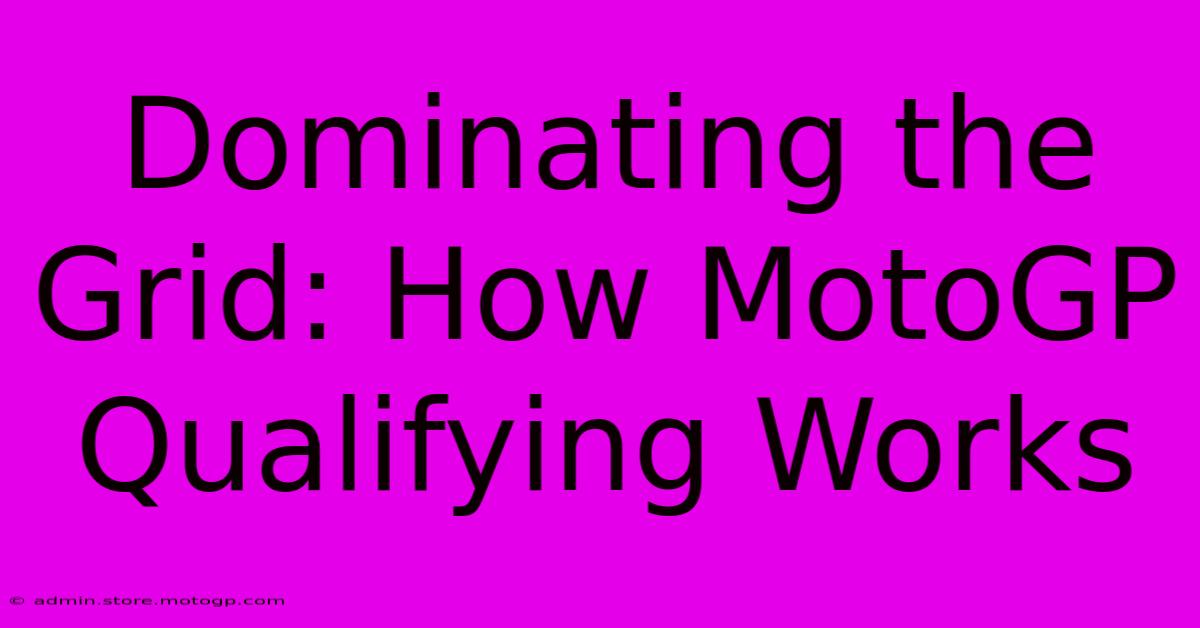Dominating The Grid: How MotoGP Qualifying Works

Table of Contents
Dominating the Grid: How MotoGP Qualifying Works
MotoGP, the pinnacle of motorcycle racing, is a spectacle of speed, skill, and strategy. But before the lights go out and the race begins, there's a crucial stage that determines starting positions: qualifying. Understanding how MotoGP qualifying works is key to appreciating the drama and the intricacies of the sport. This guide will break down the process, explaining the different sessions and the strategies employed by riders and teams.
The Qualifying Format: A Battle Against the Clock
MotoGP qualifying isn't a simple time trial. It's a multi-session process designed to separate the wheat from the chaff, rewarding precision and consistency. The current format comprises three sessions:
1. Free Practice (FP1 & FP2): Laying the Foundation
The weekend begins with two free practice sessions (FP1 and FP2). These sessions allow riders to familiarize themselves with the track, test different bike setups, and gather crucial data. While these sessions don't directly determine grid positions, they're vital for setting the stage for qualifying. Data collected during FP1 and FP2 informs tire choice, fuel strategies, and bike adjustments for the crucial qualifying sessions. Rider feedback is paramount in optimizing the machine for performance.
2. Qualifying 1 (Q1): The Fight for Q2
The combined times from FP1 and FP2 determine which riders participate in Q1. The slowest 10 riders (excluding those already guaranteed a Q2 place) compete in this 15-minute shootout. Only the two fastest riders from Q1 advance to Q2. This session is high-pressure, with riders pushing their machines and themselves to the limit to secure a place in the next round. Aggressive riding and calculated risks are commonplace here.
3. Qualifying 2 (Q2): The Battle for Pole Position
The top 10 riders from the combined FP times, plus the two fastest riders from Q1, make up the grid for Q2. This 15-minute session is the ultimate test, where riders fight for the coveted pole position – the best starting spot on the grid. The rider with the fastest lap time at the end of Q2 secures pole position. The grid positions from second to tenth are determined by the subsequent fastest lap times. Tire management, race simulations, and slipstream tactics are crucial in this high-stakes session. The pressure is immense, and every tenth of a second counts.
Strategies and Tactics: The Art of MotoGP Qualifying
MotoGP qualifying is as much a strategic game as it is a test of speed. Teams and riders employ various tactics to gain an advantage:
- Tire Management: Choosing the right tires and managing their wear throughout the qualifying sessions is critical. The correct tire selection is fundamental to determining lap times. Finding the optimum tire performance within the constraints of the qualifying sessions is critical to maximize lap times.
- Slipstreaming: Drafting behind another rider to reduce air resistance and gain speed is a common tactic, particularly in Q2. Timing the slipstream perfectly is key to gaining those crucial hundredths of a second.
- Track Conditions: Changes in track temperature and grip throughout the sessions significantly impact performance. Teams meticulously monitor these conditions and adjust their strategies accordingly. Adaptability is a key attribute for success.
- Bike Setup: Fine-tuning the bike setup between sessions is essential. Small adjustments can make a huge difference in lap times. The attention to detail is evident in this aspect of racing.
Beyond the Qualifying Sessions: The Importance of the Grid
Starting position significantly impacts the race. A front-row start provides a considerable advantage, allowing riders to control the race pace and avoid the chaos of the opening laps. Securing a good grid position is therefore crucial for a successful race day. The implications of grid positioning are evident throughout the season.
In Conclusion: MotoGP qualifying is a complex and captivating process that blends raw speed with calculated strategy. Understanding the intricacies of the qualifying sessions provides a deeper appreciation for the skill and determination of the world's top motorcycle racers. The quest for pole position is a microcosm of the entire season's battles, a compelling prelude to the main event.

Thank you for visiting our website wich cover about Dominating The Grid: How MotoGP Qualifying Works. We hope the information provided has been useful to you. Feel free to contact us if you have any questions or need further assistance. See you next time and dont miss to bookmark.
Featured Posts
-
Moto Gp Helmet Myths Debunked
Feb 20, 2025
-
Tnt Moto Gp The Definitive Moto Gp Experience
Feb 20, 2025
-
Cota Parking The Complete Guide
Feb 20, 2025
-
Moto Gp Classification Understanding The Impact Of Each Race
Feb 20, 2025
-
Moto Gp Helmets Designed To Minimize Impact
Feb 20, 2025
